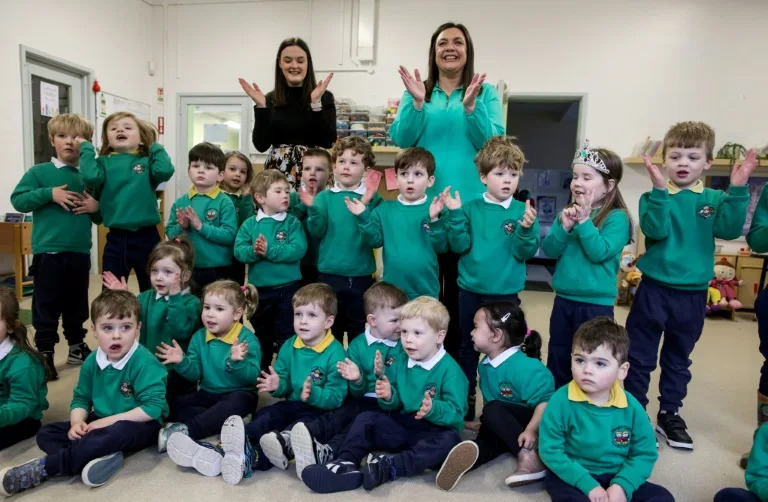“There’s room for us all to learn together while having fun,” sing the little ones in one of only two nursery schools that educate in diversity in Northern Ireland, where a vast majority of Catholics and Protestants continue to study in separate schools.
The 1998 Peace Agreement recognized that, after 30 years of inter-communal conflict that left more than 3,500 people dead, reconciliation required promoting “a culture of tolerance at all levels of society, including initiatives to facilitate and encourage integrated education”.
Twenty-five years later, in the 2022/23 academic year only 27,183 of the 355,968 pupils (7.64%) attend such “integrated” schools as Bangor Integrated Nursery School, the second in the entire region in early childhood education.
In 2019 “we held a vote among parents” and “97% said they would support” the transformation, explains to AFP its director Pamela Algie, surrounded by balloons and cakes to celebrate its new status after a long review by the Department of Education.
They must now have “40% of children of Catholic origin, 40% of children of Protestant origin and 20% of children of other origins in the same class,” she explains.
Although this movement began in 1981, it was not until 2022 that the Northern Ireland devolved parliament passed a law to encourage more public schools – with mainly Protestant pupils – and charter schools – mainly Catholic – to move towards integration.
Both currently accept students from other communities, but they are in the minority and their programs do not actively educate in the knowledge of their differences.
Instead here, “we talk about diversity, equality, respect and inclusion,” explains Algie.
“And we don’t shy away from difficult topics either, like talking about race, religion or our cultures,” she adds, despite the fact that her noisy students are between the ages of 3 and 4.
Parents play a crucial role in this movement, which advanced thanks to their drive.
Trina Zellie, a 39-year-old banking systems trainer, enrolled her two daughters at Bangor Integrated.
“We want them to be able to not only acquire English, literacy and math skills, but also develop their interpersonal skills,” she explains.
Among these parents, middle-class professionals, there are certainly practicing Catholics and Protestants, but also many non-believers and foreigners who did not live through the conflict.
– “Two segregated communities” –
The segregated schools are more than 90%.
In them, “it’s all about studies, getting good grades, but there’s nothing about preparing students for the outside world, nothing about teaching them the history of Northern Ireland,” says Lorraine Clayton, who worked for years in that system before teaching at Priory Integrated College in Holywood.
Here her students reject stereotypes and prejudices, have friends from all backgrounds and hope to change Northern Irish society.
“If we don’t start moving forward and becoming more progressive, we will be stuck in a cycle of religion, religion, religion, religion, when there are other, deeper issues that need to be addressed,” says Anna McKittrick, 18, who previously studied at a Protestant school.
“I hope our generation can do something in politics, learn the lessons,” says Charlie Durham-Crummey, from a lapsed Catholic family.
But, given the few seats, they are a drop in the ocean.
“If we want to change, we have to change the education system first,” advocates Derek Tsang, also 18.
To enable more students to interact with the other community, “shared education” emerged in 2007, explains expert Danielle Blaylock of Queen’s University Belfast.
“It’s about two or three schools partnering so that young people can move freely between them,” for example if one offers a language or sport that the other doesn’t have, she specifies.
In 2018 this concerned 60,000 pupils, but the government wants to extend it to “close to 80% in the coming years,” he adds.
Unlike integration, “shared education allows schools and students to maintain their identity when they interact,” he explains, considering that the authorities can privilege it to reach more families, including those reluctant to integration.
Why is progress so slow? “Probably because there is a hard core, two segregated communities” that are resisting, says Emma Hassard of the Fund for Integrated Education.
“Money is another factor,” she says, since the regional government must guarantee the provision of Irish and English, Protestant, Catholic and integrated schools, as well as special education. “And it’s a huge financial burden,” he stresses.

